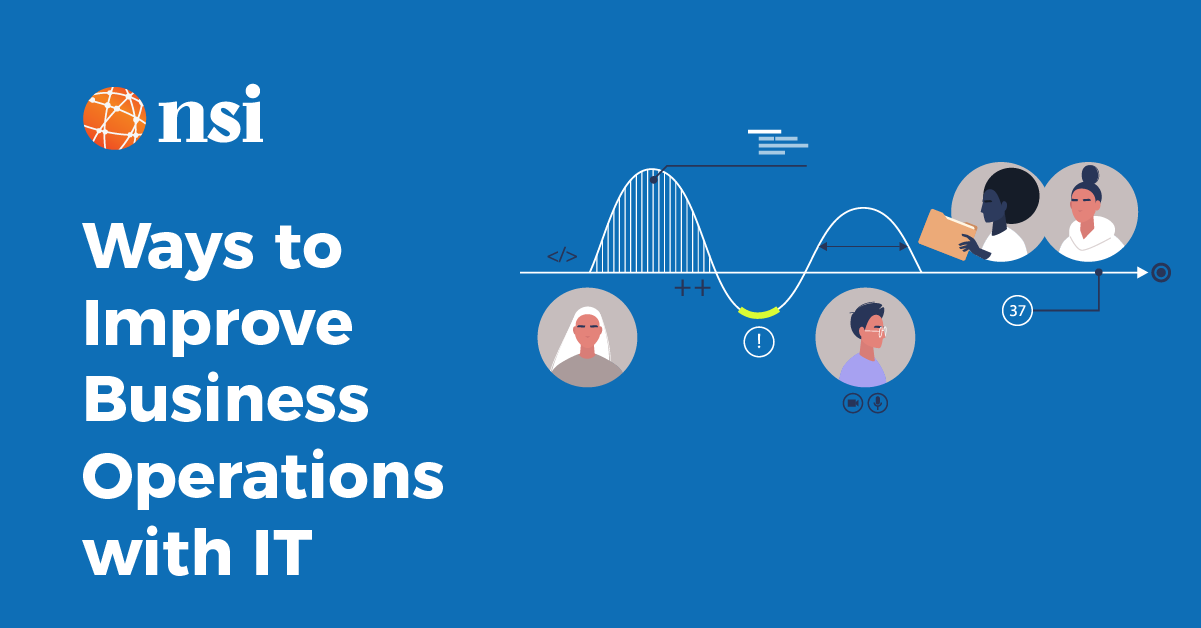
You don’t need to be in the IT industry to know that technology is essential to every aspect of business. We all get it – IT is important. The problem is that discussions about IT focus too much on technology and all its bells and whistles. It’s time to change that focus.
In this blog, we are going to focus on something different (and more important): business operations and outcomes.
Here are four ways you can improve business operations and outcomes with IT.
1. Automating Manual Processes
Automation can deliver massive gains for your business – productivity gains, innovation gains, competitiveness gains, profitability gains, and more. With effective automation, you can do more, do it better, and do it with less.
Okay, let's take it back a bit. There are tasks and processes in your business that you wouldn't think of doing manually. Running financial reports, for example, or processing invoices at the end of the day/week/month. Instead, technology automates these processes for you.
However, most Connecticut businesses are only scratching the surface of the potential that automation offers. There are multiple tasks, large and small, that are currently done manually that could be automated through modern IT solutions, freeing up employees to focus on tasks that are value-adding to the business.
Additionally, you will get a fast return on your investments in automation technologies, plus ROI can often be measured objectively through metrics like increased productivity, reduced staffing costs, improved customer satisfaction rates, etc.
2. Improved Integration
Okay, this one sounds like a technical spiel, but stick with it as the point is actually about data (and some other benefits too). Not just raw data, either, but useful data – data that will give you enhanced oversight over all aspects of the business while also helping to improve decision making.
With good data, you, other senior executives, managers, and staff at all levels can start making more decisions based on historical facts, real-time information, and predictive analytics.
Now back to the point: integration. A lack of integration is one of the main reasons why businesses can't fully unlock the power of data. When we talk about integration, we mean integrating systems, platforms, and applications.
The reality for most businesses is that their IT infrastructure and tools evolve over time. New elements are added, old elements become redundant, and there is an over-reliance on legacy systems. Most importantly, the IT systems, platforms, equipment, and applications that you rely on for the smooth running of your business can't always talk to each other. They either have limited capabilities or are completely siloed, resulting in minimal flows of information.
Integration and connectivity are the solutions, plus they are a crucial component of digital transformation.
Access to data isn't the only benefit of integration, though. You will also benefit from the efficiency savings that IT integration brings, as well as streamlined workflows. There will be less double work, and your business will become more flexible and agile as it won't be restricted by the limitations of unconnected elements of IT.
3. Enhanced Communication and Collaboration
The question of communication and collaboration can cause frustration with some senior executives, as your team already has technology that enables collaboration. They have emails and instant messaging, CRM systems and project management tools, mobile phones and laptops. What more do they need?
Furthermore, if you asked employees, you might find they spend more time on communication and collaboration tasks than they do on tasks that improve quality, move projects forward, and enhance the business.
A good MSP will understand this. They will know how to help your team spend less time on communication and collaboration while improving the effectiveness of both.
Using the right tools is crucial to achieving these objectives, as is ensuring everyone on your team is using the same tools. In many businesses, this is not the case, as teams and individuals use what they think is best. This might show initiative, but it leads to inefficiency.
So, a good MSP can help identify the right communication and collaboration tools for your business, and they can help put in place the structures that will make them successful.
There is more. A proactive MSP will also help you establish procedures for communication and collaboration, and they will make sure you are protected from cybersecurity threats. After all, communication and collaboration tools make up a large part of the cybersecurity risk landscape.
4. Improved Experiences
Two of the big buzzwords in business today are customer experience (CX) and employee experience (EX). They are more than on-trend buzzwords, however, as they are becoming increasingly relevant to the success of businesses in almost all industries.
The reasons for this are varied, but they center on the fact that both customer and employee expectations have changed.
For example, customers now have access to instant information and communication, so they expect this level of responsiveness from the brands and companies they interact with. They are also used to personalized experiences in everything from their Instagram feed to their Netflix recommendations to the ads they see as they browse the internet. Then, when they interact with brands or potential suppliers, they expect the interactions to be professional, relatable, and meaningful.
A similar range of examples applies to employee expectations, particularly as companies move away from the recruitment treadmill approach to one where the goal is to retain employees over the medium and long term.
Here is the main point: IT is central to the continuous improvement of both customer and employee experiences.
Looking at customers, for example, they should have a consistent and memorable experience at every touchpoint with your brand, with interactions being meaningful and seamless. Let's put that in context using an example of a customer in the market for the services or products you provide.
That customer may encounter your brand through social media, via a Google search, and by clicking on an ad. Each of these interactions should address the concerns or desires of the customer, while also showing you have the solution.
The potential customer makes contact through a form on your website, followed by further conversations and interactions. Those interactions should flow seamlessly, regardless of who is engaging with the potential customer on your side.
The process to purchase the product or service should also be seamless, as should the delivery, with any issues or concerns dealt with promptly and efficiently.
The above is a standard scenario that would be familiar to most businesses, but it is full of potential CX pitfalls. The website could present errors, for example, or the customer might not get a response to their query because the form was broken, or the CRM wasn't connected properly. The customer might also start a chat on the website only to find there are no agents available to talk to them, or they might have an issue post-purchase that they can't get resolved because of communication problems.
IT and a proactive MSP are crucial to preventing these CX failures from occurring. The right MSP provider and the right technologies will also help you improve the experiences you offer to customers and your employees.
The Real Power of IT
You will derive the biggest benefits from technology in your business when decisions about IT are linked to tangible business outcomes. This requires an MSP who isn’t fixated on technology.
Instead, you need an MSP passionate about delivering IT solutions that transform and improve Connecticut businesses. This is our approach at NSI. To discuss the opportunities that IT and digital transformation offers your business, get in touch with us today.








